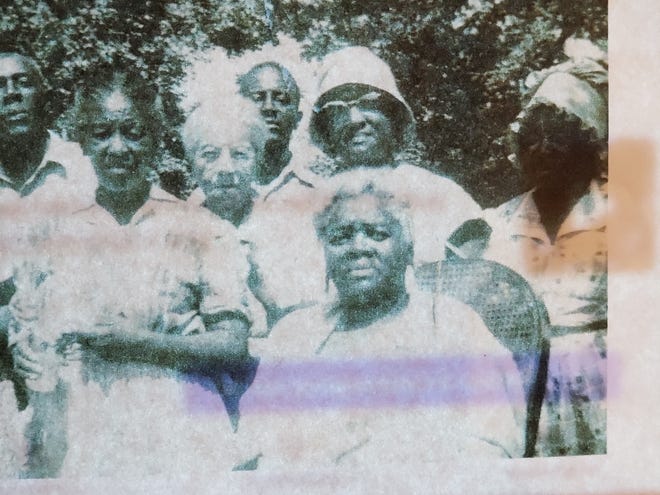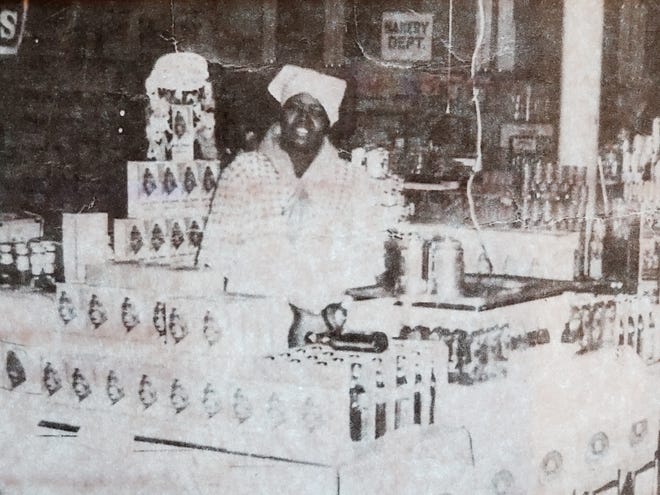
For a young Black woman trying to make her way near the turn of the last century, job options were few. In most cases, she worked for a white family, caring for their children, cleaning their house or doing their laundry.
But in 1911, when Lillian Richard left her hometown of Hawkins, Texas to seek domestic work in Dallas, she found a different opportunity – offering cooking demonstrations and becoming one of the original faces of the Aunt Jemima pancake brand. Despite the kerchiefed caricature on the packaging, being a brand ambassador allowed Richard to travel as well as make a living, and brought her renown in her community.
“I want people to know she was a real person,” says her great-niece Vera Harris. “She wasn’t just some cartoon character. She … had feelings like we all have and just wanted to make a living at the age of 20. She was happy and proud of the work she did.’’
Aunt Jemima. Uncle Ben’s. Cream of Wheat. Mrs. Butterworth. The images associated with those iconic brands not only sold syrup, rice and cereal but perpetuated painful stereotypes that negatively shaped how African Americans and women were perceived for generations.
Now, amid a national reckoning on racism in the wake of the deaths of George Floyd, Breonna Taylor and other African Americans killed by police, the makers of those products are changing or reviewing their controversial branding.
“It is symbolic, but … symbols have real power,” said Gregory Smithers, a history professor at Virginia Commonwealth University who co-authored the book “Racism in American Popular Media: From Aunt Jemima to the Frito Bandito.”
“Symbols give shape and texture to our everyday reality,” he continued. “They inform how we see other people, other cultures. They inform how we vote, how politicians make priorities and pass laws. And they inform what we see as acceptable forms of representation.”
But behind some of those symbols or images, however distorted, were real men and women with families, ambitions and lives.
Two men named Frank
Frank Brown was the man whose image became the face of Uncle Ben’s in 1946, says Caroline Sherman, a spokeswoman for Mars Food, the brand’s parent company.
Brown was a maitre d’ in a Chicago restaurant. Not much else is known about him, but Sherman says there is an effort underway to learn more.
“I don’t have a lot of details about his past,” she says, “but that’s what we’re hoping to gather as we go forward.’’

The name Uncle Ben apparently came from an African American farmer in Texas who was renowned for his high-quality rice. According to the brand’s website, Gordon Harwell and his partner who co-founded the grains line decided to change the name of what was previously called Converted Brand Rice in the late 1940s to draw in new customers. They came up with the new name while having dinner at a favorite Chicago restaurant.
The brand attempted a makeover in 2007 when “Ben” became a successful, modern businessman instead of a servant. But in the current moment, Mars has decided that shift didn’t go far enough and says it plans to change the image on the packaging, though it doesn’t know when or what those changes will be.
Learning more about Brown will help inform the process, Sherman says. “Getting more and more information and perspective about the past is only going to help that process be stronger,” she says.

A bit more is known about Frank L. White, a chef who is believed to be the model for the image used on boxes of Cream of Wheat.
White was born on the island of Barbados around 1867, then moved to the U.S. seven years later and got his citizenship in 1890, according to a June 2007 story by the Associated Press, which cited a Lansing State Journal interview with researcher Jesse Lasorda.
Cream of Wheat debuted in 1893 and initially featured a fictional character dubbed “Rastus,” a racist term for Black men depicted as simple-minded and irresponsible that arose during the minstrel era. But around the turn of the last century, White’s picture was taken while he worked at a restaurant in Chicago, according to the AP.
The man whose likeness became the new face of the cereal brand wasn’t identified at the time. But White claimed it was him, and the story became part of local lore in Leslie, Michigan, the town where White lived for roughly two decades before his death on Feb. 15, 1938, according to a report in the Jackson Citizen Patriot cited by AP.
“We understand there are concerns regarding the chef image, and we are committed to evaluating our packaging and will proactively take steps to ensure that we and our brands do not inadvertently contribute to systemic racism,” B&G Foods said in a news release about reviewing the brand image. “B&G Foods unequivocally stands against prejudice and injustice of any kind.”
In 2007, White’s grave at Woodlawn Cemetery got a new granite marker. It included an etching of the chef portrayed on the Cream of Wheat Box.
“Everybody deserves a headstone,” Lasorda, who led the effort for the new marker, told the Lansing State Journal.
The meaning of ‘Mammy’
Conagra Brands, the maker of Mrs. Butterworth’s, has said that the syrup bottles shaped like a matronly woman were “intended to evoke the images of a loving grandmother.”
But last month, Conagra became one of several companies to say it would start “a complete brand and packaging review … We stand in solidarity with our Black and Brown communities and we can see that our packaging may be interpreted in a way that is wholly inconsistent with our values.”
Mrs. Butterworth is not believed to be modeled after a real person, but to some she conveys a disturbing stereotype of a servile Black woman who is content to spend her life waiting on whites.
“That’s a clear appropriation of the “’mammy” motif,” says Smithers, explaining how that caricature was “loyal, subservient, and always ready with some down-home wisdom … That imagery became so ingrained in the way Americans saw race in the 20th century that it fit almost unnoticed into a panoply of similarly offensive marketing campaigns.”
One of the most controversial of those campaigns was that of Aunt Jemima.
The brand was born in 1889 when owners Chris Rutt and Charles Underwood created the pancake mix. The original image on the packaging was inspired by Nancy Green, “a storyteller, cook and missionary worker,” according to the brand’s website.
Green was born into slavery in Kentucky and worked as a cook and housekeeper for a judge on the south side of Chicago, says Smithers. She first performed as Aunt Jemima at the World’s Fair in Chicago in 1893 and went on to play the character in print and on radio for many more years.
Smithers says it doesn’t appear that Green received royalties for the use of her likeness. Her income mostly came from her job as a housekeeper and the small fee she was paid for her advertising appearances.
“One myth that needs quashing is the idea that Green died a millionaire,” he says. “It’s simply not true.” She was, however, “able to live (a) comfortable life and donate money to her church.”
Green was the first of a rotating cast of women — at least four, perhaps a dozen — whose likenesses were referenced on Aunt Jemima packaging, or who played the character at cooking demonstrations and in print, radio and TV ads.
“The imagery naturalized the idea that African American women existed merely to serve white people,” Smithers says. “That subservient imagery proved harmful on a number of levels. It informed popular assumptions about Black womanhood. It shaped the way people interacted with Black women, (including) exposing them to sexual violence, and informed the racism that punctuated not only pop culture, but Twentieth-Century feminist movements, politics, and social history.”
But some descendants of the women who played Aunt Jemima say their stories are more complicated.
‘Acknowledge these women’
Richard’s family believes she was the third woman to portray Aunt Jemima. Born in 1891, the fifth of eleven children, Richard eventually left her hometown to try to earn a better living.
“You can’t think about 2020,” says Harris, her great-niece. “You have to go back and try to imagine how it was in 1911 … If you were a woman, you did domestic work. You were cooks, you were maids. You took care of white people’s children. So she went out for better opportunities because Dallas was much larger than Hawkins, Texas. She knew if she went there she could find domestic work and it would pay more.’’
Instead, Richard began promoting Aunt Jemima products, putting on demonstrations at stores, fairs, and other events. It was a job she would do for the next 23 years.
“They’d bring her back in a fancy car,” Harris says of her great aunt’s employer. “Her brothers and sisters and friends would be all excited to see her when she came home because she had stories to tell them about what she saw in the places she went to. She kind of became a little celebrity.”
Richard never had children, but was married twice, first around 1912 to a man named Golden Leflore who died roughly two years later of tuberculosis. She later married James Diggs in 1935, but he also died, says Harris.
Richard retired after suffering a stroke and returned home to Hawkins where she was cared for by relatives. She died in 1956.
Harris says her family remains proud of Richard’s legacy, hosting a pancake breakfast for the Hawkins community every March where a relative, dressed as Richard portraying Aunt Jemima, takes to the stage to talk about Richard’s life.
And Harris says the city erected a historical marker to Richard in 1995, in the neighborhood where she grew up. There is also a sign that proclaims Hawkins is the pancake capital of Texas and the former home of Richard who it notes portrayed Aunt Jemima.
“Not only is our family proud of her,” Harris says, “but the community as a whole.”
Harris says she is fully supportive of the Black Lives Matter movement that is calling for racial equity and justice. She also understands Quaker Oats’ decision to change the name and imaging of its Aunt Jemima brand, which the company — now a part of PepsiCo — said in a statement is “based on a racial stereotype,” despite a revamp in 1989 where the character stopped wearing a red bandanna and donned pearl earrings instead.
But “we don’t want her history to be wiped away,” Harris said of Richard. “My aunt was a smart lady.”
Harris has contacted Quaker Oats and says she would like the company, which bought the Aunt Jemima brand in 1926, to consider creating a commemorative box that lists all the women who played the character on the back.
That might include Anna Robinson, who according to the brand’s website took on the role at the second Chicago World’s Fair in 1933 and then toured the nation, earning enough income “to provide for her children and buy a 22-room house” where she rented out rooms.
Asked if it planned such a commemoration, Quaker said in an emailed statement that it didn’t have anything to add beyond its previous announcement that it would be changing Aunt Jemima’s branding. “We’re in the process of working on the packaging redesign, but no final decisions have yet been made.”
But Harris says the box could perhaps display photos of the women as they looked when they weren’t dressed in costume.
“Say something like ‘We wouldn’t be where we are without the blood, sweat and tears of these Aunt Jemimas’,” she says. There could also be a short explanation about why the image is no longer used. “But let the world know these were vital, live people. They weren’t minstrel, made-up characters. … Acknowledge these women.”
Follow Charisse Jones on Twitter @charissejones

You can check out the latest casting calls and Entertainment News by clicking: Click Here
Click the logo below to go to the Home Page of the Website
Click the logo below to follow ETInside on Twitter
Click the logo below to follow ETInside on Facebook
Click the logo below to follow ETInside on Instagram
Click the logo below to follow ETInside on Pinterest
Click the logo below to follow ETInside on Medium

















